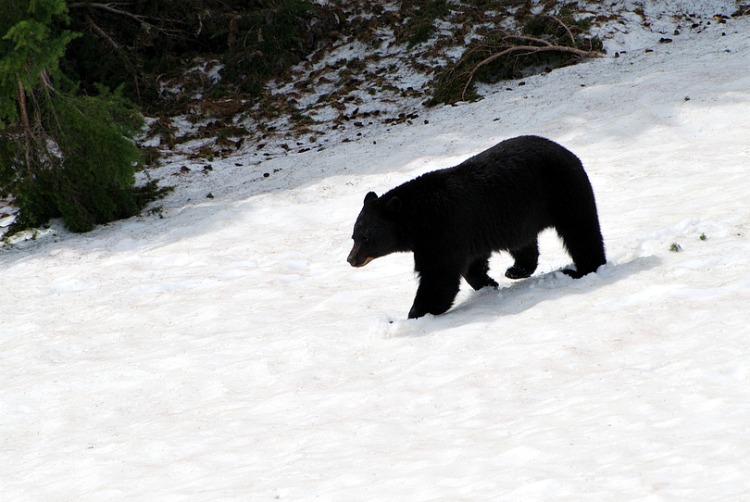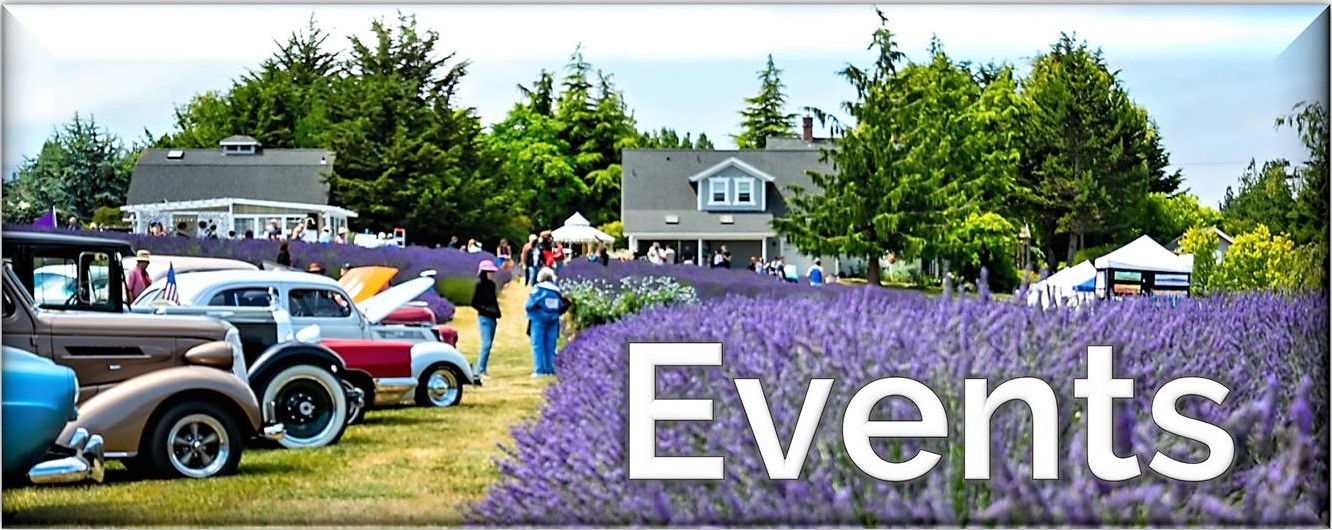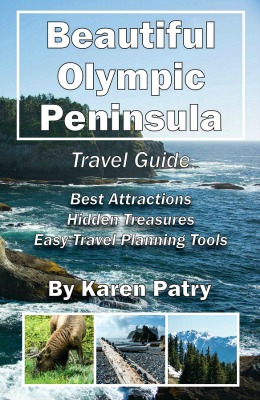American Black Bear
American Black Bear information, especially the subspecies, Olympic Black Bear. Habitat, physical characteristics, photos, history, bear viewing.
The American Black bear (Ursus americanus) is the smallest, and most widely distributed bear species in the United States. Subspecies of the black bear are found regionally through North America, and the Olympic Peninsula is no exception. The Olympic Black Bear (Ursus americanus altifrontalis) is our own native black bear species.
Brief History of the Olympic Black Bear
The Olympic Black bear was first documented during a biological survey of animals in the Crater Lake, Oregon, area in 1896. But it wasn't until 1903 that it was officially recognized as a separate black bear species by American zoologist, Daniel Giraud Elliot.
Habitat and Range
The Olympic Black bear can be found throughout the southern half of British Columbia and throughout Washington State. Their range extends south to northwestern California, west of the Cascade mountain range in OR and CA.
Like most black bears, it prefers forest areas and meadows, much like you might find throughout the Olympic National Park.
Ursus americanus is listed by the IUCN as "least concern" - not threatened.
Characteristics of the Olympic Black Bear
The size of the Olympic Black Bear is fairly average for a black bear species, though larger than both the California and Cinnamon black bears.
99% of black bears in Washington are black in color, though dark brown individuals are occasionally seen. Visitors are more likely to see white to cream colored black bears in SW British Columbia; even blue-tinted bears have been spotted in BC and coastal Alaska.
Average lifespan in the wild is estimated to be about 18 years, with a maximum age of 30 for those in captivity.
A distinguishing feature of the Olympic subspecies of black bear include a wide, bulging forehead and a tan nose.
Photo Credit: Flickr user Turcottes78 (CC 2.0)
General Info about American Black Bears
Olympic Black Bears are simply a subspecies of the American Black Bear, which exhibit these physical characteristics:
- American black bears are generally 5-6 feet long. A male might weigh between 104–551 pounds (49.4 - 250 kg), with females weighing about 33% less (86–375 pounds, or 39 - 170 kg).
- The American black bear is an apex predator classified as an omnivore.
- The black bear's facial structure includes a broad skull, with a narrowing muzzle and big jaws (10-12 inches [25.4 - 30.5 cm] total for a male).
- Small, round ears sit far back on the head.
- Claws are short and curved, black or gray-brown; with a thick base that tapers to a point. A black bear is extremely dexterous, which aids in tree climbing, swimming, digging up insects or roots, and handling fruit, nuts or berries for meals.
- The fur is soft, and has two layers – a dense underfur, as well as thick, coarse outer hairs. Coat color variation can range from white, blond, cinnamon, to a dark chocolate brown or jet black.
- Though a black bear possesses good hearing and eyesight, their most acute sense is by far the sense of smell, which is seven times greater than that of a dog.
- American black bears are excellent swimmers and tree climbers.
For more information on the American Black Bear and its physical characteristics, please visit https://www.americanbear.org.
Did You Know?
--Winnie the Poo was named for Winnipeg, a black bear cub living at the London Zoo from 1915 - 1934
--Smokey Bear, mascot of the United States Forest Service (USFS), was in fact a real bear cub with singed feet after getting caught in the Capitan Gap fire of 1950
--The Teddy Bear was named after President Teddy Roosevelt, who refused to shoot a bear cub out of a tree during a hunting expedition.
Activity and Behavior
The American black bear lives independently, marking its territory by clawing tree bark, or rubbing against them.
Its home range may be as little as a five mile radius, or as great as one thousand! This varies due to location and availability of food.
Bears might be active day or night. Those bears found closer to humans tend to prefer nighttime foraging. On the other hand, individual bears living around brown bears (grizzlies) tend to be active during the day, so as not to disrupt the feeding habits of the much larger brown bears.
American Black Bear Diet
Olympic Black Bears are excellent foragers, feeding on berries, treenuts, roots, young shoots and buds. What they eat will always vary depending on what is found locally.
Non-vegetable portions include insects and larvae, eggs found in large nests, including the bald eagle, another prevalent animal found throughout the PNW.
Oh, and yes – they love honey!
Of course, favorite meals for Olympic black bears in Western Washington and British Columbia are the chinook and coho salmon found throughout the many local rivers and streams of the Pacific Northwest.
American Black Bear Reproduction and Development
Reproduction and Development
- Females (sows) have their first litter between 3–5 years old, though they might become fertile younger in more developed areas
- The breeding period lasts for 2–3 months, usually June-July, sometimes August in more northern regions. Fertilized eggs don't implant until November
- The pregnancy lasts 235 days. Litters are usually born in January-February
- Litters average 2-3 cubs, with possibly as many as 6.
Cubs
- Cubs weigh less than a pound at birth and are approximately 8 inches in length
- Eyes open between 28–40 days
- Start walking after 5 weeks
- Cubs nurse for 30 weeks, reaching independence at 16–18 months
- At 6 months old, they will weigh between 40-60 pounds
Photo Credit wild trees: Flickr; (CC 2.0)
Hibernation
- Prior to hibernating, bears gain up to 30 pounds (13.6 kg) of body fat.
- They enter their dens in October or November. Bears aren't too picky about where to hibernate, choosing hollowed out tree cavities, under logs or rocks, in caves or banks, and in shallow depressions.
- Typically, the hibernation period lasts 3–8 months, depending on regional climate.
- Hibernation results in a drop in heart rate from 40–50 beats per minute to 8 beats per minute. Hormones suppress appetite. Waste elimination ceases; nitrogen in waste matter recycles back into protein manufacturing, preventing muscle loss. Body temperature remains fairly stable so that the bear remains moderately aware.
Native Black Bear Mythology
Black bears feature prominently in many native American stories.
The Haida, Tlingit, and Tsimshian peoples learned respect for bears when a girl married the son of a black bear Chieftain, according to stories retold through the ages.
Many native stories characterize the black bear as "good," whereas the brown bear (grizzly) is characterized as "evil."
What to do if you encounter an American Black Bear in the Wild
 Olympic Black Bear pictured along the Mount Angeles Trail high in the Olympic National Park in 2010.
Olympic Black Bear pictured along the Mount Angeles Trail high in the Olympic National Park in 2010.Photo Credit Michael Vieira, Flickr; CC 2.0 Generic
So you are out hiking with your family or friends along one of the many scenic trails deep in Olympic National Park. Suddenly, several yards ahead you spot an Olympic Black Bear foraging just off to one side of the trail. What do you do?
Here are some key actions you should (or should not) take:
- First and foremost, remain calm. Remember: Bears rarely attack humans.
- Talk calmly while avoiding eye contact with the bear (so as not to challenge it)
- DO NOT RUN (bear might begin to chase you)
- Calmly pick up small children, quieting them so they will not run or surprise bear by making much noise
- Restrain your dog(s)
- Back away slowly, or make a wide circle around bear. Never crowd or cut off a bear's escape route
- If the bear stands, this does not mean he will charge, a standing bear only wants a better look
- If the bear does feel threatened, he might slap the ground, huff, lunge, or chomp
Note: If you will be hiking or backpacking through black bear territory such as the Olympic National Park, it is advisable to carry bear spray. Not pepper spray -- bear spray.
Tips for maintaining a safe, bear-free campsite:
Set Up:
- Follow Park guidelines when applicable
- Investigate the area upon arrival, look for signs of bears – markings, scat, etc., remain highly alert
- Do not camp near bear food sources (berry bushes, etc.)
- Use the '100 yard rule' – set up tents 100 yards (99.44 m) upwind from cooking areas
- Take care on how you set up tents
Food Storage and Cooking:
- Never leave food out
- Do not bring food into tents
- Always store food properly when leaving the camp site
- Purchase bear-resistant containers – bears are clever animals and can often manage to open coolers, latches, even car doors!
- Avoid foods with strong odors
- Hang food and garbage beyond the reach of bears as needed
- Wash dishes immediately
Click here for lots more info and tips on bear safety while hiking, backpacking and camping in the PNW, including how to properly use bear spray, and a link to a PSA video on bear safety.
Hiking the extensive trails within the Olympic National Park is probably the best way to encounter the Olympic subspecies of the American Black Bear.
Unless they come to us!
All who wander are not lost from John Gussman on Vimeo.
Bears do occasionally wander near Hurricane Ridge or rarely down into the nearby lowlands surrounding the Olympic National Park. The young Olympic black bear in the video above had wandered into Dungeness Bay and onto Marine Drive in Sequim, Washington, an extremely rare occurrence.
Cities near Hurricane Ridge in the Olympic National Park:
- Port Angeles: 20 miles (32.2 km), approx. 40 minutes
- Forks: 68 miles (109.4 km), approx. 1.6 hours
- Sequim: 35 miles (56.3 km), approx. 70 minutes
- Aberdeen via Hwy 101N along Hood Canal: 162 miles (approx. 3.5 hours)
- Aberdeen via Hwy 101N along the Pacific coast: 176 miles (approx. 3.7 hours)
- Seattle to Olympic National Park Visitor Center in Port Angeles: 82 miles (132 km), approx. 2.7 hours
- Seattle: 100 miles (160.9 km), approx. 3.1 hours
Have You Encountered Temperate Rainforest Wildlife?
Tell Your Story and Share Your Photos With Us!
Tell Your Story and Share Your Photos With Us!
Nature can present us with unexpected, breathtaking, and memorable moments! Do you have a great story or an interesting experience encountering any of the many Temperate Rainforest Wildlife species? We'd love to hear about it! Feel free to share it in the form below. Be as wordy and as descriptive as you like. Include photos as well, if you have them; there is plenty of room for it all on our website.
Just click into the title box below and go from there. When published, you'll have "your own" page on MyPortAngeles which you can share with friends or anyone who asks!
We're happy to ensure professional and amateur photographers get credit for their work. Leave us your name in the form below, and means of contact, website, or FB page info so we can link back to you.








